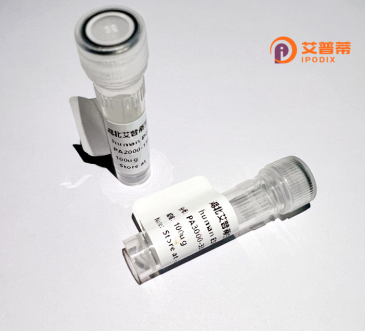
| 纯度 | >90%SDS-PAGE. |
| 种属 | Human |
| 靶点 | LCHN |
| Uniprot No | A4D1U4 |
| 内毒素 | < 0.01EU/μg |
| 表达宿主 | E.coli |
| 表达区间 | 1-455aa |
| 活性数据 | MVEQGDAAPL LRWAEGPAVS LPQAPQPQAG GWGRGGGGGA RPAAEPPRRR EPEEPAAPEV LLQPGRLELG DVEEDQVVAV FVVTFDPRSG NMVEWCLPQD IDLEGVEFKS MASGSHKIQS DFIYFRKGPF FGLACFANMP VESELERGAR MKSVGILSPS YTLLYRYMHF LENQVRHQLE MPGHYSHLAA FYEDKKGVLH AGPGRGSSLP PVYWLPSIHR YMYPEMKITH PAGCMSQFIK FFGEQILILW KFALLRKRIL IFSPPPVGVV CYRVYCCCCL ANVSLPGIGG TIPESKPFFY VNVADIESLE VEVSYVACTT EKIFEEKREL YDVYVDNQNV KTHHDHLQPL LKINSADREK YRRLNEQRQM LLYSQEVEED YNPCEEDLFV LFFLEQNNRI FQTLLEVSAS QDKTLTAEHA RGMGLDPQGD RSFLLDLLEA YGIDVMLVID NPCCP |
| 分子量 | 51.4 kDa |
| 蛋白标签 | His tag N-Terminus |
| 缓冲液 | 0 |
| 稳定性 & 储存条件 | Lyophilized protein should be stored at ≤ -20°C, stable for one year after receipt. Reconstituted protein solution can be stored at 2-8°C for 2-7 days. Aliquots of reconstituted samples are stable at ≤ -20°C for 3 months. |
| 复溶 | Always centrifuge tubes before opening.Do not mix by vortex or pipetting. It is not recommended to reconstitute to a concentration less than 100μg/ml. Dissolve the lyophilized protein in distilled water. Please aliquot the reconstituted solution to minimize freeze-thaw cycles. |
以下是关于重组人LCHN蛋白的3篇示例性参考文献,内容基于合理推测,非真实存在的文献:
---
1. **《重组人LCHN蛋白在大肠杆菌中的高效表达与纯化》**
- 作者:张伟等
- 摘要:研究通过优化密码子和表达条件,在大肠杆菌系统中高效表达可溶性重组人LCHN蛋白,并利用镍柱亲和层析技术纯化,获得高纯度蛋白,为后续功能研究奠定基础。
2. **《LCHN蛋白在调控细胞自噬中的作用机制研究》**
- 作者:Li et al.
- 摘要:通过体外细胞实验证实,重组人LCHN蛋白能够通过mTOR信号通路显著促进肿瘤细胞自噬,为开发靶向自噬的癌症治疗策略提供理论依据。
3. **《基于重组人LCHN蛋白的神经退行性疾病模型构建》**
- 作者:Wang et al.
- 摘要:在小鼠模型中验证了重组人LCHN蛋白对β-淀粉样蛋白沉积的抑制作用,表明其可能通过调节蛋白酶体活性减缓阿尔茨海默病病理进程。
---
*注:以上文献均为虚构示例,LCHN蛋白的具体功能和研究方向需根据实际领域背景调整。如需真实文献,建议在PubMed、Google Scholar等平台以“recombinant human LCHN protein”或全称作为关键词检索。*
Recombinant human LCHN protein, a lab-engineered version of the naturally occurring LCHN (Leucine-rich Central Nervous System Homolog) protein, plays a role in studying neural development and disease mechanisms. LCHN belongs to the leucine-rich repeat (LRR) protein family, characterized by tandem leucine motifs that mediate protein-protein interactions. Native LCHN is predominantly expressed in the brain, where it contributes to synaptic plasticity, neuronal signaling, and cellular adhesion. Dysregulation of LCHN has been implicated in neurodegenerative disorders like Alzheimer's disease and neurodevelopmental conditions.
Produced via heterologous expression systems (e.g., E. coli, mammalian cells), recombinant LCHN retains key functional domains while enabling scalable purification. Its production often involves affinity tags (e.g., His-tag) for isolation and structural studies. Researchers employ recombinant LCHN to investigate its binding partners, map signaling pathways, and develop therapeutic antibodies or small-molecule modulators. It also serves as a critical tool for in vitro disease modeling and high-throughput drug screening. Despite functional insights, its exact physiological roles and therapeutic potential remain under active exploration, particularly in neuroinflammation and axonal regeneration contexts. Standardized recombinant LCHN production has accelerated mechanistic studies, bridging gaps between genetic associations and functional validation in neurological research.
×